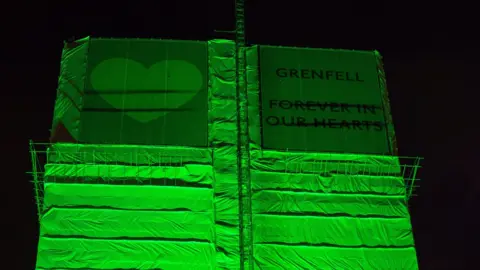Raft of safety flaws listed at Grenfell Tower Inquiry
 EPA
EPAA list of failed safety regulations has been presented to a public inquiry into the Grenfell Tower blaze.
Dr Barbara Lane said lifts in the tower were sub-standard, fire doors had not been replaced and combustible material was fitted around windows.
She said the "very basis" of the policy telling people to stay in their flats during a fire only worked alongside other protection measures.
But the standards firefighters relied on "failed" at 01:26 GMT.
A total of 72 people died as a result into the fire on 14 June 2017 in North Kensington, west London.
Dr Lane, a chartered fire safety engineer, released a report about the fire two weeks ago, but on Monday gave evidence to Sir Martin Moore-Bick's inquiry.
The hearing was told that Grenfell Tower was completed in 1974 and had 19 different sets of works on it up until 2017.
But a number of the additions or refurbishments did not comply with regulations, according to Dr Lane.
'No escape hatches'
She said the lifts in the building were not up to the standard for firefighters, despite having been refurbished in 2005.
The doors were not as fire resistant as they needed to be and did not have a secondary power supply.
Dr Lane also said the lifts had no escape hatches, making them unsuitable for the evacuation of disabled people.
 AFP/Getty Images
AFP/Getty ImagesDr Lane then described how only 106 of the 120 doors in the tower were replaced after additional refurbishments in 2011, meaning it is assumed the other doors had been there since 1974.
At that time, building regulations meant they only had to be fire resistant for 20 minutes - but current regulations raises this to an hour.
She told the inquiry: "Fire doors are a crucial element of the stay-put strategy, as they represent an opportunity for weak spots to form in the fire-resistant partitions that separate a flat fire from occupants either on that floor where the fire has started or occupants in the flat above the floor the fire has started.
"Fire doors are, therefore, a building regulations requirement as a passive fire protection measure. Faulty fire doors mean faulty compartmentation and compartmentation is the primary basis of the stay-put strategy."
Water pressure
Dr Lane also said the dry rising mains in the tower - through which firefighters pump water to tackle fires in high-rise buildings - were also not suitable for a building of its height.
Dr Lane said the dry riser loses effectiveness as the height of the building increases and rely on good water pressure to work against gravity.
But eventually, the lack of water pressure means it cannot operate effectively.
Buildings more than 50m in height should have a pressurised tank already in the building for firefighters to use, yet Grenfell Tower - measuring 67.3m - did not have one.
Gas pipes
A gas pipe installed in 2016 penetrated both the protected stair compartment wall and the protected flat compartment walls, Dr Lane added.
She said the pipe - one of six gas risers running vertically up the block - had incomplete compartmentation and ventilation around it to protect it from fire.
The hearing continues on Tuesday from 10:00 BST with further experts giving evidence throughout the week.
